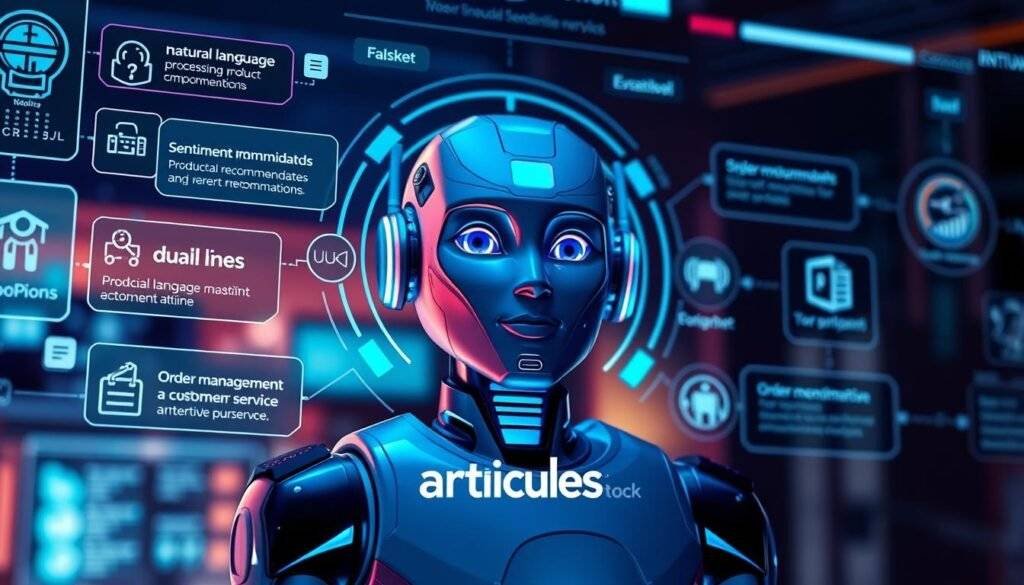AI chatbot for ecommerce store setup. The ecommerce landscape is rapidly evolving, and businesses are turning to innovative solutions to stay ahead. One such game-changer is the AI chatbot, designed to transform the way online stores interact with their customers.
With the ability to provide 24/7 customer support and personalized shopping experiences, chatbots are becoming increasingly popular in the ecommerce industry. These sophisticated platforms have evolved from simple Q&A bots to complex AI agents capable of handling intricate workflows, making them an essential tool for any ecommerce business.
By implementing an AI chatbot, ecommerce businesses can significantly reduce operational costs while improving customer satisfaction and conversion rates. As we explore the world of ecommerce chatbots, we’ll examine the essential capabilities, must-have features, and step-by-step implementation strategies for setting up an effective solution.
Key Takeaways
- Discover how AI chatbots can revolutionize your ecommerce business with 24/7 customer support.
- Learn about the evolution of ecommerce chatbots and their current capabilities.
- Understand the benefits of implementing an AI chatbot, including reduced operational costs and improved customer satisfaction.
- Explore essential features and implementation strategies for setting up an effective AI chatbot.
- Review top AI chatbot platforms designed specifically for ecommerce businesses.
Understanding AI Chatbots for Ecommerce
With the growth of ecommerce, AI chatbots are emerging as a key solution for businesses to provide 24/7 customer support. Conversational AI in e-commerce is popular for a reason; it improves the customer experience with 24/7 access and personalized recommendations, and it can streamline order processing for employees.
What Are Ecommerce AI Chatbots?
Ecommerce AI chatbots are virtual assistants that help customers navigate online stores, answer questions, and facilitate purchases. They function as an integral part of the ecommerce platform ecosystem, providing a more human-like interaction between businesses and their customers.
These chatbots leverage natural language processing (NLP) and machine learning to understand customer queries and respond accordingly. By doing so, they offer a more personalized shopping experience, helping customers find what they’re looking for more efficiently.
The Evolution from Simple Q&A Bots to AI Agents
The evolution of chatbots has been significant, from simple rule-based systems to sophisticated AI-powered agents capable of understanding context and intent. Modern ecommerce chatbots have become more than just customer service tools; they’re an essential part of the ecommerce customer journey.
As quoted by a leading expert, “The future of ecommerce is not just about transactions, it’s about creating an experience.” AI chatbots are at the forefront of this shift, enabling businesses to provide a more engaging and personalized experience for their customers.
Why AI Chatbots Are Transforming Online Stores
AI chatbots are transforming online stores by offering 24/7 customer support, personalized shopping experiences, and streamlined operations. This transformation is driven by the ability of AI chatbots to scale high-quality customer interactions and produce data-driven insights about customer preferences.

24/7 Customer Support and Engagement
One of the primary advantages of AI chatbots is their ability to provide round-the-clock customer support. By eliminating wait times, chatbots ensure that customers receive immediate assistance regardless of their time zone or business hours. This constant availability enhances customer satisfaction and fosters a positive shopping experience.
Personalized Shopping Experiences
AI chatbots deliver personalized shopping experiences by analyzing customer data, browsing history, and purchase patterns to offer tailored product recommendations. This level of personalization not only improves customer engagement but also increases the likelihood of conversion.
Streamlined Operations and Cost Savings
By automating routine customer service tasks, AI chatbots help streamline operations and reduce the burden on human support agents. This automation leads to significant cost savings, with research indicating that chatbots save businesses billions annually in customer service expenses.
According to Salesforce, AI influenced 17% of U.S. holiday sales in 2023, demonstrating its impact on ecommerce sales. Furthermore, Juniper Research reports that AI chatbots save brands over $11 billion every year. By leveraging these technologies, ecommerce businesses can enhance customer interactions, improve sales, and reduce operational costs.
Essential Capabilities of AI Chatbot for Ecommerce Store Setup
To maximize the potential of an ecommerce AI chatbot, it’s vital to understand the essential capabilities that make it effective. These capabilities not only enhance customer experience but also streamline operations, driving sales and reducing costs.

Customer Query Management
Efficiently managing customer queries is crucial for providing excellent customer service. AI chatbots can instantly respond to frequently asked questions about products, shipping, returns, and store policies, ensuring customers have the information they need.
Product Recommendations and Assistance
Advanced product recommendation capabilities analyze customer preferences and browsing behavior to suggest relevant items, increasing average order value. This personalized approach helps customers discover new products that meet their needs.
Order Processing and Tracking
AI chatbots can streamline order processing and tracking by integrating with inventory and shipping systems. This integration provides real-time updates and resolves order-related issues promptly, enhancing customer satisfaction.
Cart Abandonment Recovery
Identifying and recovering abandoned carts is a critical capability of AI chatbots. Through timely follow-ups, personalized offers, and addressing potential purchase obstacles, chatbots can significantly reduce cart abandonment rates.
Visual Search Capabilities
The growing importance of visual search capabilities allows customers to upload images to find similar products. This feature enhances the shopping experience for visually-oriented consumers, making it easier for them to discover and purchase products.
By incorporating these essential capabilities, ecommerce businesses can leverage AI chatbots to improve customer engagement, increase sales, and optimize operational efficiency. The strategic use of data and analytics further enhances these capabilities, ensuring that the chatbot remains effective and relevant.
Must-Have Features When Choosing an Ecommerce Chatbot
When selecting an ecommerce chatbot, it’s crucial to consider the features that will enhance your customer experience and streamline your operations. A well-integrated chatbot can significantly improve customer satisfaction and operational efficiency.
CRM and Platform Integrations
For enterprise chatbots, CRM integrations are a must. By connecting your AI chatbot to a CRM, you can update records, send messages or emails, and sell directly to shoppers. This integration enables your chatbot to access customer data, order history, and inventory information, allowing for seamless interactions and workflow automation.
Omnichannel Support
A website chatbot serves only a small portion of potential customers. To extend your business’s reach, your chatbot should be deployable across multiple channels, including Instagram, WhatsApp, and Facebook Messenger. Omnichannel support ensures that your chatbot maintains consistent conversations across various platforms, providing a cohesive customer experience.
Customization Options
To align chatbot interactions with your brand voice and visual identity, you need customization options. This allows you to tailor the chatbot’s responses and appearance to match your brand, ensuring a consistent customer experience. Customization also enables you to implement specific customer service protocols, further enhancing the customer experience.
Analytics and Reporting Tools
Monitoring your AI chatbot is crucial to understanding its performance and identifying areas for improvement. Analytics and reporting tools provide insights into chatbot performance, customer satisfaction, and conversation patterns. By leveraging these insights, you can continuously improve your chatbot system, ensuring it remains effective and efficient.
| Feature | Description | Benefit |
|---|---|---|
| CRM Integration | Connects chatbot to customer relationship management system | Seamless customer data access and workflow automation |
| Omnichannel Support | Deploys chatbot across multiple platforms | Consistent customer experience across channels |
| Customization Options | Allows tailoring of chatbot’s appearance and responses | Alignment with brand voice and visual identity |
| Analytics and Reporting | Provides insights into chatbot performance and customer satisfaction | Data-driven improvements to chatbot system |
Top AI Chatbot Platforms for Ecommerce
As ecommerce continues to grow, the demand for sophisticated AI chatbot platforms has never been more pressing. With numerous options available, selecting the right platform can be a daunting task. In this section, we’ll explore the top AI chatbot platforms for ecommerce, examining their features, pros, and cons to help you make an informed decision.
Botpress

Overview
Botpress is a versatile AI chatbot platform that offers endless customizability and extensibility. It’s always up-to-date with the latest LLM engines, ensuring its chatbots and AI agents are powered by the most recent technology.
Pros
Botpress offers a visual drag-and-drop canvas for developers, automatic translations for over 100 languages, and pre-built integrations to popular software and channels. Its flexibility makes it an ideal choice for businesses seeking a highly adaptable chatbot solution.
Cons
While Botpress offers extensive customization options, this may result in a steeper learning curve for some users. Additionally, the platform’s flexibility may require more development effort to fully leverage its capabilities.
Features
Botpress’s key features include its visual development canvas, automatic translations, and extensive integration capabilities. These features enable businesses to create customized chatbots that can be seamlessly integrated into their ecommerce platforms.
Octane AI

Overview
Octane AI is a powerful conversational AI commerce platform designed to seamlessly integrate with Shopify. It provides merchants with the tools to create personalized, AI-powered chatbots and quizzes that drive engagement and sales.
Pros
Octane AI’s seamless Shopify integration and quiz-building functionality make it an attractive choice for ecommerce businesses. Its ability to create personalized shopping experiences enhances customer interactions and drives sales.
Cons
Octane AI’s focus on Shopify may limit its appeal for businesses using other ecommerce platforms. Additionally, some users may find the platform’s feature set to be too specialized, limiting its broader applicability.
Features
Octane AI’s key features include its Shopify integration, quiz-building functionality, and ability to create personalized shopping experiences. These features enable businesses to drive engagement and sales through targeted customer interactions.
BotStar

Overview
BotStar is a flexible chatbot platform designed to support businesses of all sizes with customer engagement. It’s a no-code solution used by ecommerce businesses to improve customer service, generate leads, and deliver personalized experiences.
Pros
BotStar’s no-code approach and robust omnichannel support make it an accessible choice for businesses without extensive technical expertise. Its flexibility and customization options enable businesses to tailor their chatbot solutions to their specific needs.
Cons
While BotStar offers a range of features, some users may find its customization options to be limited compared to more developer-focused platforms. Additionally, the platform’s no-code approach may not be suitable for businesses with complex chatbot requirements.
Features
BotStar’s key features include its no-code development, omnichannel support, and customization options. These features enable businesses to create effective chatbot solutions that enhance customer engagement and drive sales.
LivePerson

Overview
LivePerson is a conversational AI platform that enables businesses to build AI-driven chatbots and live messaging solutions. It offers tools for creating, managing, and optimizing customer interactions across a wide range of channels.
Pros
LivePerson’s advanced conversational AI and real-time customer engagement capabilities make it an ideal choice for enterprise-level businesses. Its comprehensive analytics tools enable businesses to optimize their chatbot solutions and improve customer interactions.
Cons
LivePerson’s enterprise-level focus may make it less accessible to smaller businesses or those with limited budgets. Additionally, the platform’s complexity may require significant technical expertise to fully leverage its capabilities.
Features
LivePerson’s key features include its advanced conversational AI, real-time customer engagement, and comprehensive analytics tools. These features enable businesses to create sophisticated chatbot solutions that drive customer engagement and improve sales.
ManyChat

Overview
ManyChat is a no-code solution that allows businesses to create powerful AI-driven chatbots without any coding experience. It specializes in helping businesses engage with customers through social media and messaging apps, particularly Facebook Messenger.
Pros
ManyChat’s user-friendly interface and focus on social media integration make it an attractive choice for businesses seeking to enhance customer engagement through popular messaging platforms.
Cons
ManyChat’s focus on social media may limit its appeal for businesses seeking more comprehensive ecommerce integrations. Additionally, some users may find the platform’s feature set to be too specialized, limiting its broader applicability.
Features
ManyChat’s key features include its no-code development, social media integration, and user-friendly interface. These features enable businesses to create effective chatbot solutions that drive customer engagement and improve sales through popular messaging platforms.
Step-by-Step Implementation Guide
To revolutionize your ecommerce experience, follow our step-by-step guide to setting up an AI chatbot. Implementing an AI chatbot can significantly enhance customer service and operational efficiency.
Choosing the Right Platform for Your Business
The first step is selecting a chatbot platform that integrates smoothly with your existing ecommerce ecosystem. Look for one that offers native integration with your store platform (Shopify, Magento, WooCommerce, etc.) and open APIs to connect with other tools you already use. When evaluating platforms, consider factors such as:
- Compatibility with your ecommerce platform
- Scalability to handle increased traffic
- Customization options to fit your brand voice
- Integration capabilities with other business tools
Setting Up Your Chatbot’s Conversation Flows
After connecting your chatbot platform, it’s essential to define how the chatbot interprets and responds to customer messages through intent modeling. Identify common customer queries and map out responses accordingly. This involves:
- Recognizing customer intents behind their messages
- Creating appropriate responses or actions
- Designing conversation flows that are logical and helpful
Integrating with Your Ecommerce Platform
Once you’ve established the intents and responses, the next step is to integrate your chatbot with your ecommerce platform. This involves connecting APIs, synchronizing data, and ensuring secure access to customer and product information. Key aspects include:
- API connections for data exchange
- Data synchronization for up-to-date information
- Secure access protocols to protect customer data
Testing and Optimization
Before deploying your chatbot, thorough testing is crucial. This includes A/B testing conversation flows, gathering user feedback, and continuously optimizing the chatbot’s performance based on real-world interactions. Consider:
- A/B testing to compare different conversation flows
- User feedback mechanisms to understand customer satisfaction
- Continuous optimization to improve performance
By following these steps, you can ensure a successful deployment of your AI chatbot, enhancing your ecommerce business’s customer service and operational efficiency.
Best Practices for Maximizing Chatbot ROI
Ecommerce businesses can significantly boost their chatbot’s effectiveness by adopting proven best practices. A well-implemented chatbot not only enhances customer experience but also streamlines operations, leading to increased ROI.
Maintaining a Human Touch
It’s essential to design conversational flows that feel natural and provide clear pathways to human agents when needed. This balance ensures that customers receive the support they need while maintaining a personal touch.
Regular Updates and Training
Regularly updating and training your chatbot system is crucial. This involves refining responses based on customer feedback and expanding the knowledge base to address emerging customer needs, ensuring the chatbot remains relevant and effective.
Compliance with Privacy Regulations
Ecommerce chatbots often handle sensitive customer information, making it vital to comply with privacy regulations such as GDPR and CCPA. Ensuring your chatbot handles customer data securely and transparently is not only a legal requirement but also builds trust with your customers.
To measure the success of your chatbot, focus on key performance indicators like resolution rate, customer satisfaction scores, and conversion impact. By balancing automation with personalization, you can create shopping experiences that are both efficient and emotionally engaging for customers.
Conclusion: The Future of Ecommerce with AI Chatbots
As we look to the future of ecommerce, AI chatbots are poised to revolutionize the online shopping experience. The transformative impact of these chatbots is evident in their ability to provide 24/7 customer support, personalized shopping experiences, and streamlined operations.
Ecommerce chatbots are evolving from simple customer support tools to comprehensive sales assistants that guide customers through the entire shopping journey. Emerging trends in chatbot technology, such as voice commerce integration and augmented reality product visualization, are further enhancing the ecommerce experience.
Businesses of all sizes can benefit from implementing AI chatbot solutions, thanks to their scalability and adaptability. As ecommerce chatbots continue to evolve, they may become the primary interface between online stores and their customers, driving sales and improving customer satisfaction.
